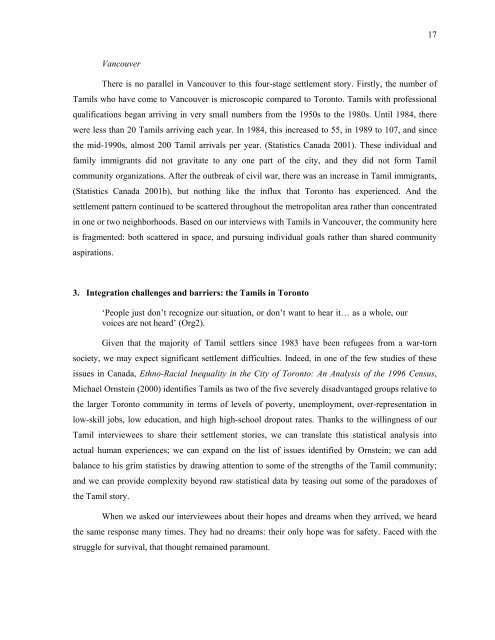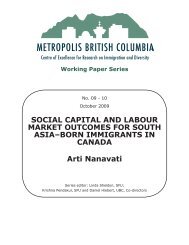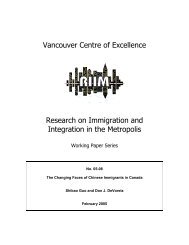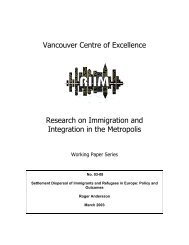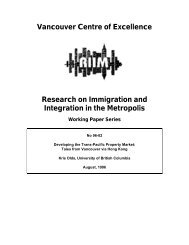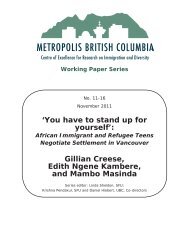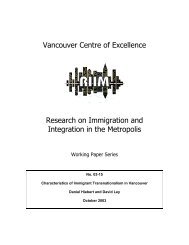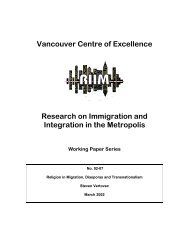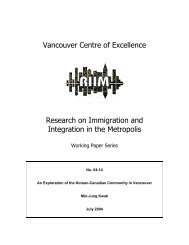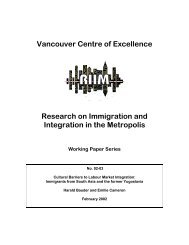The Quest for an Inclusive City - Metropolis BC
The Quest for an Inclusive City - Metropolis BC
The Quest for an Inclusive City - Metropolis BC
Create successful ePaper yourself
Turn your PDF publications into a flip-book with our unique Google optimized e-Paper software.
17<br />
V<strong>an</strong>couver<br />
<strong>The</strong>re is no parallel in V<strong>an</strong>couver to this four-stage settlement story. Firstly, the number of<br />
Tamils who have come to V<strong>an</strong>couver is microscopic compared to Toronto. Tamils with professional<br />
qualifications beg<strong>an</strong> arriving in very small numbers from the 1950s to the 1980s. Until 1984, there<br />
were less th<strong>an</strong> 20 Tamils arriving each year. In 1984, this increased to 55, in 1989 to 107, <strong>an</strong>d since<br />
the mid-1990s, almost 200 Tamil arrivals per year. (Statistics C<strong>an</strong>ada 2001). <strong>The</strong>se individual <strong>an</strong>d<br />
family immigr<strong>an</strong>ts did not gravitate to <strong>an</strong>y one part of the city, <strong>an</strong>d they did not <strong>for</strong>m Tamil<br />
community org<strong>an</strong>izations. After the outbreak of civil war, there was <strong>an</strong> increase in Tamil immigr<strong>an</strong>ts,<br />
(Statistics C<strong>an</strong>ada 2001b), but nothing like the influx that Toronto has experienced. And the<br />
settlement pattern continued to be scattered throughout the metropolit<strong>an</strong> area rather th<strong>an</strong> concentrated<br />
in one or two neighborhoods. Based on our interviews with Tamils in V<strong>an</strong>couver, the community here<br />
is fragmented: both scattered in space, <strong>an</strong>d pursuing individual goals rather th<strong>an</strong> shared community<br />
aspirations.<br />
3. Integration challenges <strong>an</strong>d barriers: the Tamils in Toronto<br />
‘People just don’t recognize our situation, or don’t w<strong>an</strong>t to hear it… as a whole, our<br />
voices are not heard’ (Org2).<br />
Given that the majority of Tamil settlers since 1983 have been refugees from a war-torn<br />
society, we may expect signific<strong>an</strong>t settlement difficulties. Indeed, in one of the few studies of these<br />
issues in C<strong>an</strong>ada, Ethno-Racial Inequality in the <strong>City</strong> of Toronto: An Analysis of the 1996 Census,<br />
Michael Ornstein (2000) identifies Tamils as two of the five severely disadv<strong>an</strong>taged groups relative to<br />
the larger Toronto community in terms of levels of poverty, unemployment, over-representation in<br />
low-skill jobs, low education, <strong>an</strong>d high high-school dropout rates. Th<strong>an</strong>ks to the willingness of our<br />
Tamil interviewees to share their settlement stories, we c<strong>an</strong> tr<strong>an</strong>slate this statistical <strong>an</strong>alysis into<br />
actual hum<strong>an</strong> experiences; we c<strong>an</strong> exp<strong>an</strong>d on the list of issues identified by Ornstein; we c<strong>an</strong> add<br />
bal<strong>an</strong>ce to his grim statistics by drawing attention to some of the strengths of the Tamil community;<br />
<strong>an</strong>d we c<strong>an</strong> provide complexity beyond raw statistical data by teasing out some of the paradoxes of<br />
the Tamil story.<br />
When we asked our interviewees about their hopes <strong>an</strong>d dreams when they arrived, we heard<br />
the same response m<strong>an</strong>y times. <strong>The</strong>y had no dreams: their only hope was <strong>for</strong> safety. Faced with the<br />
struggle <strong>for</strong> survival, that thought remained paramount.


